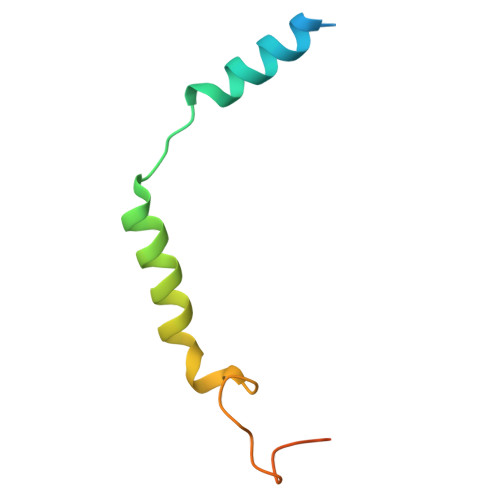High-affinity agonists reveal recognition motifs for the MRGPRD GPCR.
Wang, C., Liu, Y., Lanier, M., Yeager, A., Singh, I., Gumpper, R.H., Krumm, B.E., DeLeon, C., Zhang, S., Boehm, M., Pittner, R., Baron, A., Dvorak, L., Bacon, C., Shoichet, B.K., Martinborough, E., Fay, J.F., Cao, C., Roth, B.L.(2024) Cell Rep 43: 114942-114942
- PubMed: 39580805
- DOI: https://doi.org/10.1016/j.celrep.2024.114942
- Primary Citation of Related Structures:
9DQH, 9DQJ - PubMed Abstract:
The human MRGPRD protein is a member of the Mas-related G protein-coupled receptors (MRGPRs) that is involved in the sensing of pain, itch, and other inflammatory stimuli. As with other MRGPRs, MRGPRD is a relatively understudied receptor with few known agonists. The most potent small-molecule agonist of MRGPRD reported so far is β-alanine, with an affinity in the micromole range, which largely restricts its functional study. Here, we report two MRGPRD agonists, EP-2825 and EP-3945, that are approximately 100-fold more potent than β-alanine and determine the structures of MRGPRD-Gq in complex with EP-2825 and EP-3945, respectively. The structures reveal distinct agonist binding modes of MRGPRD and large conformational plasticity of the orthosteric pocket. Collectively, the discovery of high-affinity MRGPRD agonists and their distinct binding modes will facilitate the functional study and the structure-based design of ligands targeting this understudied receptor.
- Key Laboratory of Immune Response and Immunotherapy, Center for Advanced Interdisciplinary Science and Biomedicine of IHM, Division of Life Sciences and Medicine, University of Science and Technology of China, Hefei 230001, China; Department of Pharmacology, University of North Carolina School of Medicine, Chapel Hill, NC, USA; School of Life Sciences, Division of Life Sciences and Medicine, University of Science and Technology of China, Hefei 230001, China; Insitute of Health and Medicine, Hefei Comprehensive National Science Center, Hefei, China.
Organizational Affiliation:





















